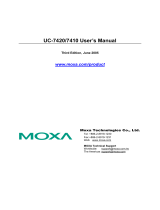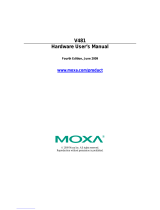Page is loading ...

— 1 — — 2 — — 3 —
UC-7420/7410
Quick Installation Guide
Third Edition, November 2005
1. Overview
MOXA UC-7420/7410 features eight RS-232/422/485 serial ports, dual
10/100 Mbps Ethernet ports, PCMCIA, and a CompactFlash interface for
wireless LAN communication and flash disk expansion, making
UC-7420/7410 ideal for your embedded applications.
2. Package Checklist
Before installing UC-7420/7410, verify that the package contains the
following items:
y 1 UC-7410 or UC-7420
y Wall-Mounting Kit
y DIN-Rail Mounting Kit
y UC-7420/7410 Quick Installation Guide (this guide)
y UC-7420/7410 Documentation & Software CD
y Cross-over Ethernet cable
y CBL-RJ45M9-150: 150 cm, 8-pin RJ45 to Male DB9 serial port cable
y CBL-RJ45F9-150: 150 cm, 8-pin RJ45 to Female DB9 console port cable
y Universal Power Adaptor
y Product Warranty Booklet
Notify your sales representative if any of the above items is missing or
damaged.
3. UC-7420/7410 Panel Layout
NOTE: UC-7420 (shown in the figures) has a CF slot, PCMCIA slot, and two
USB 2.0 Host ports (circled below). UC-7410 does NOT have these three
features.
Rear View
DC 12-48V USB
LAN1 LAN2 Console
V+ V-
PCMCIA
CF
12-48 VDC
Power Input
CF x 1
PCMCIA x 1
10/100Mbps Ethernet x 2
USB 2.0 Host x 2,
A Type Connector
USB 1.1 client x 1,
miniB Connector
RS-232
PPP/Console
Top View
Graphics LCM
160 x 64 Dots
5 Buttons
Front View
Reset
P1
RS-232/422/485
P2 P3 P4 P5 P6 P7 P8
Reset to
default
RJ45 RS-232/422/485
Connectors x 8
4. Installing UC-7420/7410
Wall or Cabinet
The two metal brackets included with UC-7420/7410 can be used to attach it
to a wall, or the inside of a cabinet. Using two screws per bracket, first attach
the brackets to the bottom of the UC-7420/7410. Next, use two screws per
bracket to attach the UC-7420/7410 to a wall or cabinet.
DIN-Rail Mounting
The aluminum DIN-Rail attachment plate is included in the package. To
attach the plate to UC-7420/7410, situate the stiff metal spring towards the
top.
STEP 1: Insert the top of the
DIN-Rail into the slot just below the
stiff metal spring.
STEP 2: The DIN-Rail attachment
unit will snap into place as shown
below.
metal
spring
DIN-Rail
metal
spring
DIN-Rail
To remove UC-7420/7410 from the DIN-Rail, simply reverse Steps 1 and 2
above.
5. Connector Description
Power Connector
Connect the 12-48 VDC power line to UC-7420/7410’s terminal block. If the
power is properly supplied, the Ready LED will show a solid green color
when the OS is ready.
Grounding UC-7420/7410
Grounding and wire routing help limit the effects of noise due to
electromagnetic interference (EMI). Run the ground connection from the
ground screw to the grounding surface prior to connecting the power.
ATTENTION
This product is intended to be mounted to a well-grounded mounting surface
such as a metal panel.
SG
SG: The Shielded Ground (sometimes called Protected
Ground) contact is the left most contact of the 3-pin
power terminal block connector when viewed from the
angle shown here. Connect the SG wire to an
appropriate grounded metal surface.
Ethernet Port
The two 10/100 Mbps Ethernet ports (LAN 1 and LAN 2) use RJ45
connectors.
Pin Signal
1 ETx+
2 ETx-
3 ERx+
6 ERx-
18
Serial Port
The eight serial ports (P1 to P8) use RJ45 connectors. Each port can be
configured by software as RS-232, RS-422, or RS-485. The pin assignments
are shown in the following table:
Pin RS-232 RS-422 RS-485
1 DSR --- ---
2 RTS TXD+ ---
3 GND GND GND
4 TXD TXD- ---
5 RXD RXD+ Data+
6 DCD RXD- Data-
7 CTS --- ---
8 DTR --- ---
18
PCMCIA
The PCMCIA slot supports the CardBus (Card-32) Card standard and 16-bit
(PCMCIA 2.1/JEIDA 4.2) Card standard. It supports +3.3V, +5V, and +12V
at a working voltage of 120 mA. Wireless LAN card expansion is optional.
The Wireless LAN card provided by Moxa lets you connect UC-7420/7410 to
a Wireless LAN, with both 802.11b and 802.11g interfaces supported.
CompactFlash
UC-7420 provides one CompactFlash slot that supports CompactFlash type
I/II card expansion. Currently, Moxa provides a CompactFlash disk for plug
& play expansion. You may also use flash disks available from most
computer supply outlets. The CompactFlash will be mounted at
/mnt/hda
P/N: 1802074000300

— 4 — — 5 — — 6 —
Console Port
The console port is an RJ45 RS-232 port. It can be connected to a V90 or
GPRS modem via PPP. The pin definitions are the same as for the eight serial
ports (P1 to P8).
Reset to Default Button
Press the “Reset to Default” button continuously for at least 5 seconds to load
the factory default configuration. After the factory default configuration has
been loaded, the system will reboot automatically. The Ready LED will blink
on and off for the first 5 seconds, and then maintain a steady glow once the
system has rebooted.
Reset Button
Press the “Reset” button to activate the hardware reset function. You should
only use this function if the software does not function properly. To reset a
Linux system, you should reboot the operating system to avoid deleting
important data.
LCM & Keypad
UC-7420/7410 Series has an LCM screen and five input buttons on the top
panel. Refer to the Moxa Device API for programming information.
The LCM can display 16 columns and 8 rows of text with ASCII code
starting from 0x20 to 0x7F. The function of the five keypad buttons can be
defined by your application.
USB
The USB 2.0 Host port now supports a USB storage device driver. The
USB 1.1 Client port is reserved for future enhancement.
Real Time Clock
UC-7420/7410’s real time clock is powered by a lithium battery. We strongly
recommend that you do not replace the lithium battery without help from a
qualified Moxa support engineer. If you need to change the battery, contact
the Moxa RMA service team.
ATTENTION
There is a risk of explosion if the battery is replaced by an incorrect type.
6. Powering on UC-7420/7410
To power on UC-7420/7410, connect the “terminal block to power jack
converter” to the UC-7420/7410's DC terminal block (located on the left back
panel), and then connect the power adaptor. Note that the Shielded Ground
wire should be connected to the right most pin of the terminal block. It takes
about 30 seconds for the system to boot up. Once the system is ready, the
Ready LED will light up, and UC-7420/7410’s network settings will appear
on the LCM display.
7. Connecting UC-7420/7410 to a PC
There are two ways to connect UC-7420/7410 to a PC, through the serial
console port or by Telnet over the network. The COM settings for the serial
console port are: Baud rate=115200 bps, Parity=None, Data bits=8, Stop
bits =1, Flow Control=None.
ATTENTION
Remember to choose the “VT100” terminal type. Use the CBL-RJ45F9-150
cable included with the product to connect a PC to UC-7420/7410’s serial
console port.
To use Telnet you will need to know UC-7420/7410’s IP address and
netmask. The default LAN settings are shown below. For first-time
configuration, you may find it convenient to use a cross-over Ethernet cable
to connect directly from the PC to the UC-7420/7410.
Default IP Address Netmask
LAN 1 192.168.3.127 255.255.255.0
LAN 2 192.168.4.127 255.255.255.0
Once the UC-7420/7410 is powered on, the Ready LED will light up, and a
login page will open. Use the following default Login name and Password to
proceed.
Login: root
Password: root
8. Configuring the Ethernet Interface
If you use the console cable for first-time configuration of the Network
settings, use the following commands to edit the interfaces file:
#ifdown –a
//Disable LAN1/LAN2 interface first, before you
reconfigure the LAN settings. LAN 1 = ixp0, LAN 2= ixp1//
#vi /etc/network/interfaces
//check the LAN interface first//
After the boot setting of the LAN interface has been modified, use the
following commands to activate the LAN settings immediately:
#sync ; ifup –a
NOTE: Refer to the UC-7420/7410 User’s Manual for information on how to
configure the WLAN interface, and other configuration information..
9. Developing Your Application
10. Installing the UC-7420/7410 Tool Chain
The PC must have the Linux Operating System pre-installed to install the
UC-7420/7410 GNU Tool Chain. Redhat 7.3/8.0, or Linux Kernel 2.4.18 and
compatible versions are recommended. The Tool Chain will use about 400
MB of your PC’s hard disk space. Use the following command to install the
Tool Chain from the UC-7420/7410 CD:
#mount /dev/cdrom /mnt/cdrom
#rpm –ivh /mnt/cdrom/mxscaleb-3.3.2-6.i386.rpm
The Tool Chain will be installed on your PC automatically.
11. Compiling and Running Hello.c
The path to the Tool Chain is:
PATH=/usr/local/mxscaleb/bin:$PATH
The UC-7420/7410 CD also includes several example programs. Here we use
Hello.c as an example to show you how to compile and run your applications.
Type the following commands on your PC:
# cd /tmp/
# mkdir example
# cp –r /mnt/cdrom/example/* /tmp/example
Next, go to the Hello subdirectory and type the following command:
#make
to finish compiling Hello.c.
Finally, run the executable file that was created to generate hello-release and
hello-debug.
NOTE: Moxa also provides the Windows Tool Chain for UC-7420/7410. The
Windows Tool Chain simulates a Linux environment on a Windows operating
system, allowing you to develop programs for UC-7420/7410 on a Windows
platform. The UC-7420/7410 User’s Manual contains complete details on
how to install the Windows Tool Chain.
Copyright © 2005
Moxa Technologies Co., Ltd.
All rights reserved.
Reproduction without permission is prohibited.
Tel: +886-2-8919-1230 www.moxa.com
Fax: +886-2-8919-1231
Power on target and
connect to PC Linux
Program
Debugged?
Install GNU cross
compiler on PC Linux
Install Glibc on
PC Linux
Install GDB client on PC
Linux (optional)
Code program
& Compile
Download to target to
run and test
Develop end user
application
Set up cross compiler
and Glibc environment
variables
Yes
No
New
Program
/




